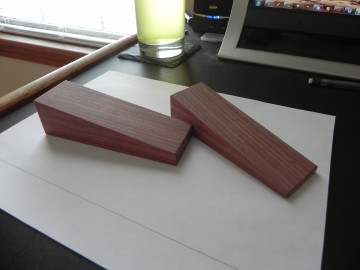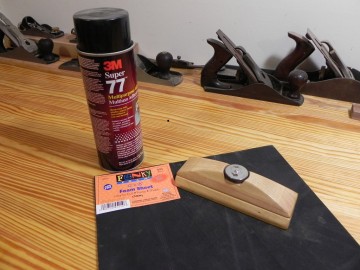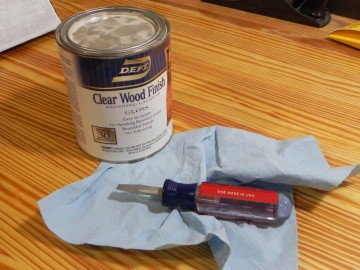I’m going to be on hiatus for a few weeks, as I have a new shop dog that needs some basic training, and a lot of attention.World, say hello to Wrigley the goldendoodle, yes I’m a Cubs fan. I won’t be on a complete hiatus, I will probably spend most of my nights designing projects (gota love Sketchup) that will be built in the spring.

Wrigley the Goldendoodle
Every now and then I get a request for a really simple item, and they are always A joy to make, because they require no planning. On Friday a friend asked if I could make a doorstop for her office, and I said sure no problem. I think this little project, took all of 30 minutes, and 20 of those where spent trying to determine what angle to cut the stop at. I settled on 10 degrees after making a couple test stops from SYP. Hopefully these stops will last a decade or two.

A pair of doorstops
I’ve spent the last week or so, experimenting with different finishing methods, in the hopes of achieving a french polished look, without the work involved in french polishing. If it works, I’ll document the method I’m testing in a future post.
If you’ve read any books on finishing, you’ve probably noticed that without exception they all recommended you cover the bottom of your sanding blocks with cork. Maybe the authors are tight with their local cork dealers, but in my neck of the woods, Cork is expensive, and hard to find. Last weekend while browsing the isles of the local hobby lobby, I found an excellent alternative in foam sheet. I’m not sure what type of foam it is, but it’s soft (but not to soft). Thus, for $0.99 (now that’s cheap) I took home a 3mm thick sheet that was 12″ by 18″, enough for a half dozen sanding blocks.
Applying the foam to the bottom of a sanding block is simple. Cut the foam to size, and then glue it to the block using spray adhesive. The adhesive is strong enough to hold the foam in place, yet weak enough that the foam can be removed with ease if it becomes damaged.

Everything you need
I got this screwdriver in a Craftsman combo set when I was fourteen or fifteen I think. They were my first tools, and if memory serves, I got them with birthday money from my great grandmother. I’m sure my father was smiling ear to ear, because I wouldn’t be “misplacing” his tools anymore. A decade and a half later and I haven’t “misplaced” any of them, and some of them still look brand new.
Last night, while opening a can of Lacquer, it hit me. The big stubby flat head is the perfect can opener. It’s easy to grip, and provides plenty of leverage for prying off lids welded down by dried finish. For the life of me, I can think of any situation that calls for a screwdriver this short. Thus it must be a can opener, masquerading as a screwdriver.

If your not aware of Chris Schwarz’s personal blog, I suggest you check it out. Lately, Chris has been spicing up his posts with quotes from old issues of “The Woodworker”. Yesterday, he posted one (duplicated below) that struck me as even more relevant today than it was in 1954.
Far to often, I find myself in the situation the author speaks of; worn down by the less glamorous aspects of my job. I’ve been making a conscious effort lately to enjoy the simple things in life, and I’ve bee slowly re-discovering what truly makes me happy. I’ve spending what little time I can with those close to me, and doing what I have done in one fashion or another since I was a child; making stuff.
So many men to-day, doing work that is far removed from the making of things, the many professional workers, office workers, salesmen, factory workers – whose work may seem to be making but whose sole contribution is constant repetitive action in one infinitesimal part – lack contact with that real world in which a man can exercise his creative gifts.
They barely realise that such a world exists.
Theirs is the world of hard bargaining, of nimble wits or the routine job, which leave a great part of their natural human instincts unsatisfied, even though in all probability they do not know the reason for their perennial feelings of dissatisfaction and frustration.
— The Woodworker, January 1954





